2015.5. PEUGEOT 3008 dashboard
[x] Cancel search: dashboardPage 8 of 344

6
Instruments and controls
Sun visor 95
Dashboard fuses
2
21-224
Opening the bonnet
1
85
Electric parking brake
14
0 -143, 145 -146
6 -speed manual gearbox
1
58
Electronic gearbox
1
59 -163
Automatic gearbox
1
64-167
Stop & Start
1
69 -171
Hill start assist
1
44-146
Eco-driving
1
2-13Front armrest
9
6
Peugeot Connect USB
9
6, 292, 318
Courtesy lamps
9
1
Seat belt / passenger's front airbag warning lamps display
1
30, 133
Rear view mirror 7 5Peugeot Connect
Navigation (RT6)
2
55 -309
Setting the date/time 3 9
Peugeot Connect Sound
(RD5)
3
11- 331
Setting the date/time
3
7
Ventilation
5
9-60
Manual air conditioning
6
1-62
Digital air conditioning
6
4-66
Demisting-defrosting the rear screen
6
3
Interior fittings
9
4-95, 97
-
g
love box
-
d
river's storage compartments
-
mat
12 V accessory socket
9
7
Over view
Page 62 of 344
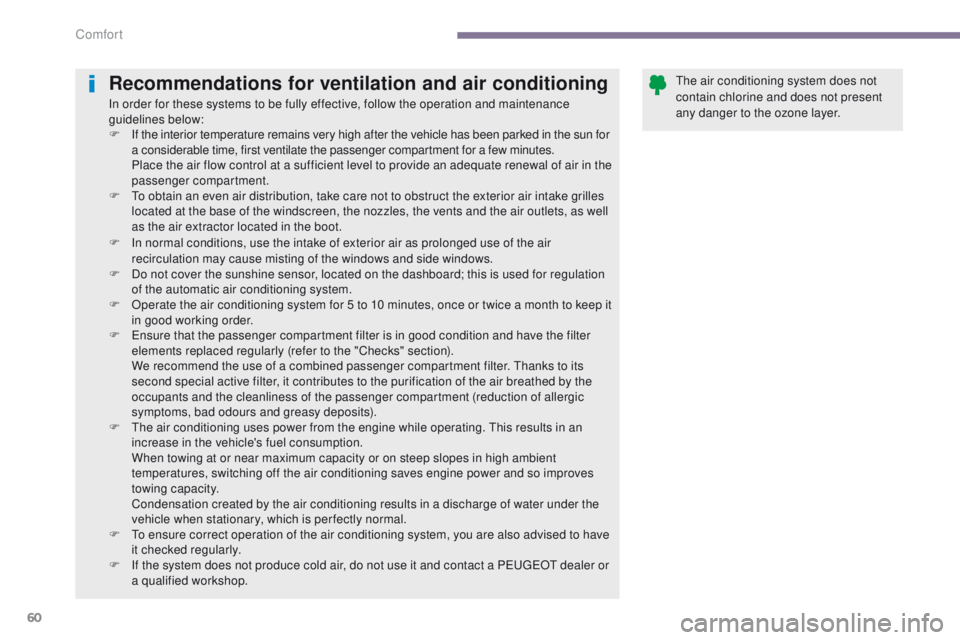
60
Recommendations for ventilation and air conditioning
In order for these systems to be fully effective, follow the operation and maintenance
guidelines below:
F
I
f the interior temperature remains very high after the vehicle has been parked in the sun for
a considerable time, first ventilate the passenger compartment for a few minutes.
P
lace the air flow control at a sufficient level to provide an adequate renewal of air in the
passenger compartment.
F
T
o obtain an even air distribution, take care not to obstruct the exterior air intake grilles
located at the base of the windscreen, the nozzles, the vents and the air outlets, as well
as the air extractor located in the boot.
F
I
n normal conditions, use the intake of exterior air as prolonged use of the air
recirculation may cause misting of the windows and side windows.
F
D
o not cover the sunshine sensor, located on the dashboard; this is used for regulation
of the automatic air conditioning system.
F
O
perate the air conditioning system for 5 to 10 minutes, once or twice a month to keep it
in good working order.
F
E
nsure that the passenger compartment filter is in good condition and have the filter
elements replaced regularly (refer to the "Checks" section).
W
e recommend the use of a combined passenger compartment filter. Thanks to its
second special active filter, it contributes to the purification of the air breathed by the
occupants and the cleanliness of the passenger compartment (reduction of allergic
symptoms, bad odours and greasy deposits).
F
T
he air conditioning uses power from the engine while operating. This results in an
increase in the vehicle's fuel consumption.
W
hen towing at or near maximum capacity or on steep slopes in high ambient
temperatures, switching off the air conditioning saves engine power and so improves
towing capacity.
C
ondensation created by the air conditioning results in a discharge of water under the
vehicle when stationary, which is per fectly normal.
F
T
o ensure correct operation of the air conditioning system, you are also advised to have
it checked regularly.
F
I
f the system does not produce cold air, do not use it and contact a PEUGEOT dealer or
a qualified workshop. The air conditioning system does not
contain chlorine and does not present
any danger to the ozone layer.
Comfort
Page 103 of 344
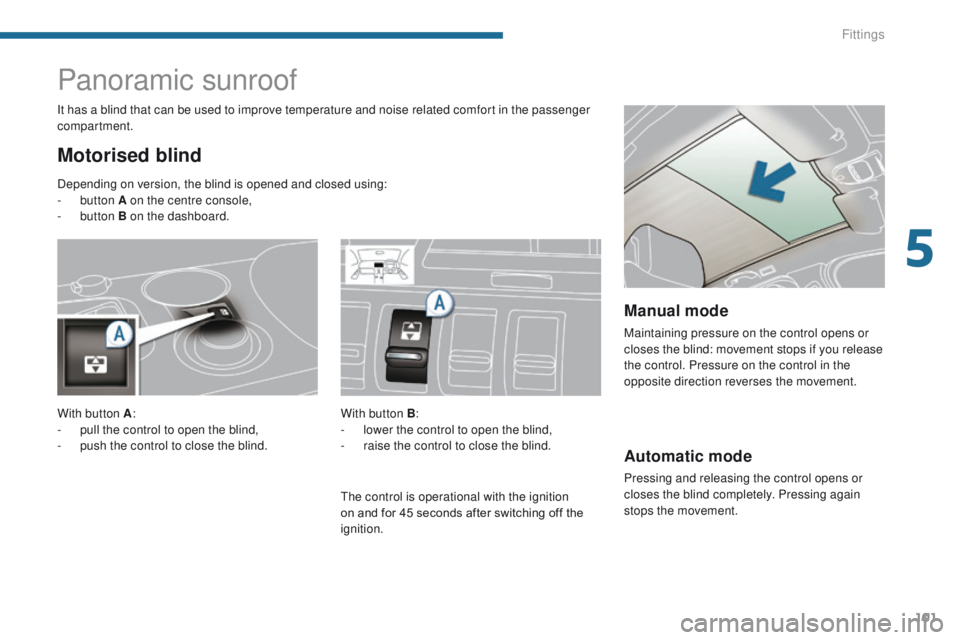
101
Automatic mode
Pressing and releasing the control opens or
closes the blind completely. Pressing again
stops the movement.
Panoramic sunroof
Motorised blind
It has a blind that can be used to improve temperature and noise related comfort in the passenger
compartment.With button B:
-
l
ower the control to open the blind,
-
r
aise the control to close the blind.
Manual mode
Maintaining pressure on the control opens or
closes the blind: movement stops if you release
the control. Pressure on the control in the
opposite direction reverses the movement.
Depending on version, the blind is opened and closed using:
-
button
A on the centre console,
-
button
B on the dashboard.
With button A :
-
p
ull the control to open the blind,
-
p
ush the control to close the blind. The control is operational with the ignition
on and for 45 seconds after switching off the
ignition.
5
Fittings
Page 134 of 344
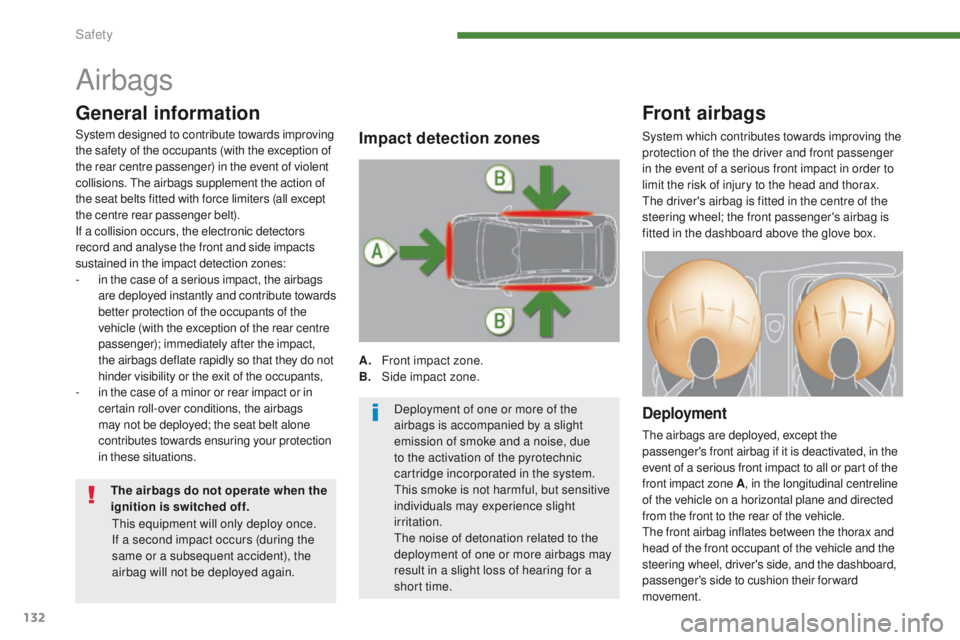
132
Airbags
Front airbags
Deployment
The airbags are deployed, except the
passenger's front airbag if it is deactivated, in the
event of a serious front impact to all or part of the
front impact zone A, in the longitudinal centreline
of the vehicle on a horizontal plane and directed
from the front to the rear of the vehicle.
The front airbag inflates between the thorax and
head of the front occupant of the vehicle and the
steering wheel, driver's side, and the dashboard,
passenger's side to cushion their forward
movement.
Impact detection zones
A. Front impact zone.
B. S ide impact zone.
General information
System designed to contribute towards improving
the safety of the occupants (with the exception of
the rear centre passenger) in the event of violent
collisions. The airbags supplement the action of
the seat belts fitted with force limiters (all except
the centre rear passenger belt).
If a collision occurs, the electronic detectors
record and analyse the front and side impacts
sustained in the impact detection zones:
-
i
n the case of a serious impact, the airbags
are deployed instantly and contribute towards
better protection of the occupants of the
vehicle (with the exception of the rear centre
passenger); immediately after the impact,
the airbags deflate rapidly so that they do not
hinder visibility or the exit of the occupants,
-
i
n the case of a minor or rear impact or in
certain roll-over conditions, the airbags
may not be deployed; the seat belt alone
contributes towards ensuring your protection
in these situations. System which contributes towards improving the
protection of the the driver and front passenger
in the event of a serious front impact in order to
limit the risk of injury to the head and thorax.
The driver's airbag is fitted in the centre of the
steering wheel; the front passenger's airbag is
fitted in the dashboard above the glove box.
Deployment of one or more of the
airbags is accompanied by a slight
emission of smoke and a noise, due
to the activation of the pyrotechnic
cartridge incorporated in the system.
This smoke is not harmful, but sensitive
individuals may experience slight
irritation.
The noise of detonation related to the
deployment of one or more airbags may
result in a slight loss of hearing for a
short time.
The airbags do not operate when the
ignition is switched off.
This equipment will only deploy once.
If a second impact occurs (during the
same or a subsequent accident), the
airbag will not be deployed again.
Safety
Page 137 of 344
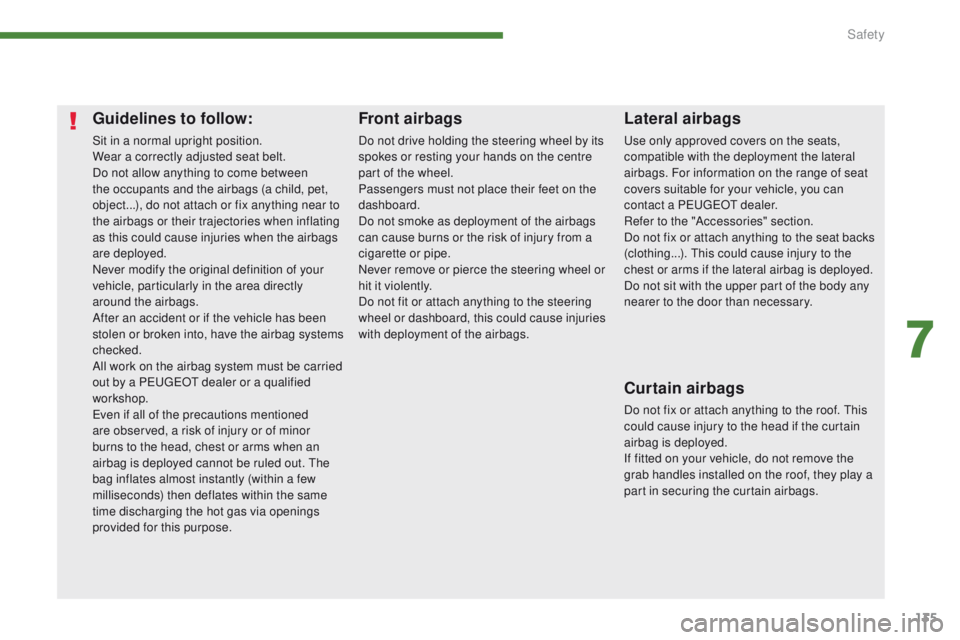
135
Guidelines to follow:
Sit in a normal upright position.
Wear a correctly adjusted seat belt.
Do not allow anything to come between
the occupants and the airbags (a child, pet,
object...), do not attach or fix anything near to
the airbags or their trajectories when inflating
as this could cause injuries when the airbags
are deployed.
Never modify the original definition of your
vehicle, particularly in the area directly
around the airbags.
After an accident or if the vehicle has been
stolen or broken into, have the airbag systems
checked.
All work on the airbag system must be carried
out by a PEUGEOT dealer or a qualified
workshop.
Even if all of the precautions mentioned
are observed, a risk of injury or of minor
burns to the head, chest or arms when an
airbag is deployed cannot be ruled out. The
bag inflates almost instantly (within a few
milliseconds) then deflates within the same
time discharging the hot gas via openings
provided for this purpose.
Lateral airbags
Use only approved covers on the seats,
compatible with the deployment the lateral
airbags. For information on the range of seat
covers suitable for your vehicle, you can
contact a PEUGEOT dealer.
Refer to the "Accessories" section.
Do not fix or attach anything to the seat backs
(clothing...). This could cause injury to the
chest or arms if the lateral airbag is deployed.
Do not sit with the upper part of the body any
nearer to the door than necessary.
Front airbags
Do not drive holding the steering wheel by its
spokes or resting your hands on the centre
part of the wheel.
Passengers must not place their feet on the
dashboard.
Do not smoke as deployment of the airbags
can cause burns or the risk of injury from a
cigarette or pipe.
Never remove or pierce the steering wheel or
hit it violently.
Do not fit or attach anything to the steering
wheel or dashboard, this could cause injuries
with deployment of the airbags.
Curtain airbags
Do not fix or attach anything to the roof. This
could cause injury to the head if the curtain
airbag is deployed.
If fitted on your vehicle, do not remove the
grab handles installed on the roof, they play a
part in securing the curtain airbags.
7
Safety
Page 223 of 344
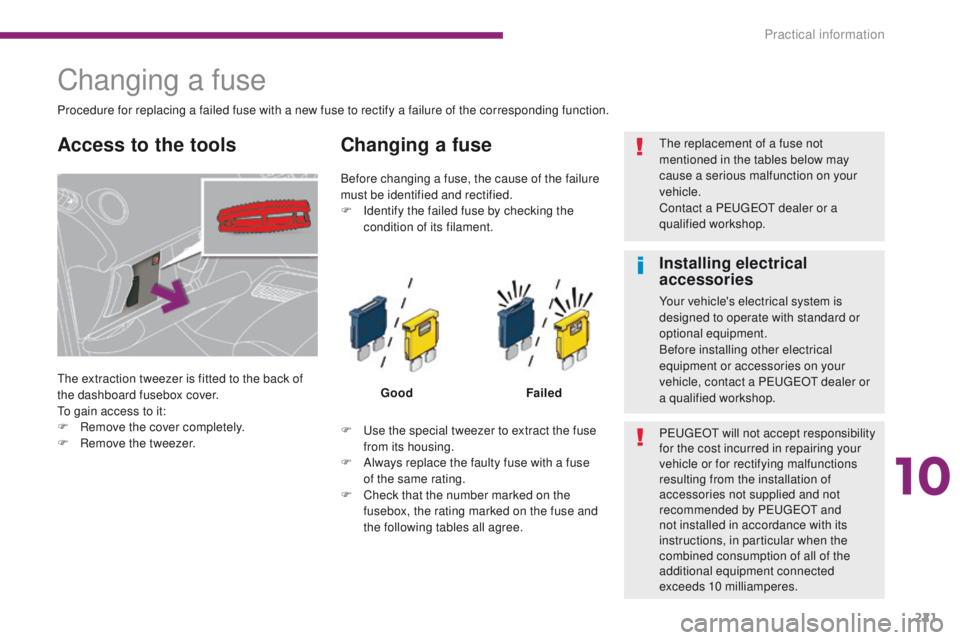
221
Changing a fuse
The extraction tweezer is fitted to the back of
the dashboard fusebox cover.
To gain access to it:
F
R
emove the cover completely.
F
R
emove the tweezer.
Changing a fuse
Good Failed
F
U
se the special tweezer to extract the fuse
from its housing.
F
A
lways replace the faulty fuse with a fuse
of the same rating.
F
C
heck that the number marked on the
fusebox, the rating marked on the fuse and
the following tables all agree.
Before changing a fuse, the cause of the failure
must be identified and rectified.
F
I
dentify the failed fuse by checking the
condition of its filament.
Procedure for replacing a failed fuse with a new fuse to rectify a failure of the corresponding function.
The replacement of a fuse not
mentioned in the tables below may
cause a serious malfunction on your
vehicle.
Contact a PEUGEOT dealer or a
qualified workshop.
PEUGEOT will not accept responsibility
for the cost incurred in repairing your
vehicle or for rectifying malfunctions
resulting from the installation of
accessories not supplied and not
recommended by PEUGEOT and
not installed in accordance with its
instructions, in particular when the
combined consumption of all of the
additional equipment connected
exceeds 10 milliamperes.
Access to the tools
Installing electrical
accessories
Your vehicle's electrical system is
designed to operate with standard or
optional equipment.
Before installing other electrical
equipment or accessories on your
vehicle, contact a PEUGEOT dealer or
a qualified workshop.
10
Practical information
Page 224 of 344

222
The fusebox is placed in the lower dashboard.
Dashboard fuses
Fuse tables
Fuse N° Rating
(A) Functions
F1 15Rear wiper.
F2 -Not used.
F3 5Airbag control unit.
F4 10Electrochrome rear view mirror, air conditioning, switching and
protection unit, rear multimedia.
F5 30Front one-touch electric windows.
F6 30Rear one-touch electric windows.
F7 5Front and rear courtesy lamps, map reading lamps, rear
reading lamps, sun visor lighting, glove box lighting, centre
armrest lighting, boot 12 V relay control.
Practical information
Page 335 of 344
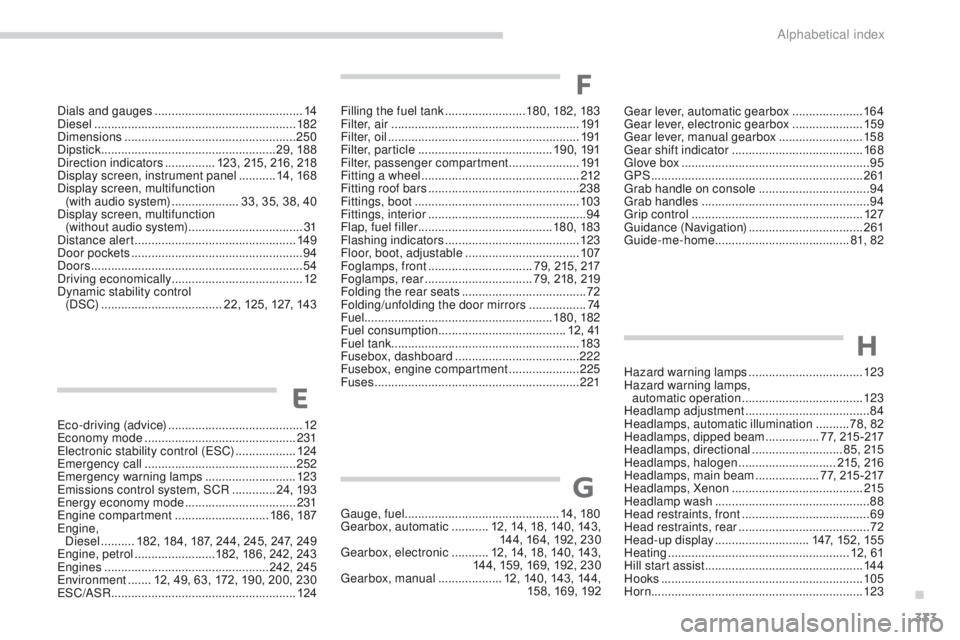
333
Eco-driving (advice) ........................................ 12
Economy mode ............................................. 231
Electronic stability control (ESC)
..................124
Emergency call
............................................. 2
52
Emergency warning lamps
........................... 12
3
Emissions control system, SCR
.............24, 193
Energy economy mode
.................................231
Engine compartment
............................186, 187
Engine, Diesel
..........182, 184, 187, 244, 245, 247, 249
Engine, petrol
........................ 182, 186, 242, 243
Engines
................................................. 242, 245
Environment
....... 1
2, 49, 63, 172, 190, 200, 230
ESC/ASR
...............................
........................124Gauge, fuel
.............................................. 14, 180
Gearbox, automatic
...........12, 14, 18, 140, 143,
144, 164, 192, 230
Gearbox, electronic
...........12, 14, 18, 140, 143,
144, 159, 169, 192, 230
Gearbox, manual
...................12, 140, 143, 144,
158, 169, 192
E
G
F
Dials and gauges ............................................ 14
Diesel ............................................................ 182
Dimensions
................................................... 250
Dipstick
................
.................................... 29, 188
Direction indicators
...............123, 215, 216, 218
Display screen, instrument panel
...........14, 168
Display screen, multifunction (with audio system)
....................33, 35, 38, 40
Display screen, multifunction (without audio system)
..................................31
Distance alert
................................................ 149
Door pockets
................................................... 94
D
oors
............................................................... 54
Driving economically ....................................... 12
Dynamic stability control (DSC)
.................................... 22, 125, 127, 143Filling the fuel tank
........................18
0, 182, 183
Filter, air ...............
.........................................191
Filter, oil
.........................................................191
Filter, particle
........................................19 0, 191
Filter, passenger compartment
.....................191
Fitting a wheel
...............................
................212
Fitting roof bars
.............................................238
Fittings, boot
................................................. 10
3
Fittings, interior
...............................................94
Flap, fuel filler
...............................
.........180, 183
Flashing indicators
........................................123
Floor, boot, adjustable
..................................107
Foglamps, front
...............................79, 215, 217
Foglamps, rear
................................79, 218, 219
Folding the rear seats
.....................................72
Folding/unfolding the door mirrors
.................74
Fuel ........................................................ 180, 182
Fuel consumption
...................................... 1
2, 41
Fuel tank ........................................................ 183
Fusebox, dashboard
.....................................222
Fusebox, engine compartment
.....................225
Fuses
.............................................................221Gear lever, automatic gearbox .....................
16
4
Gear lever, electronic gearbox
.....................159
Gear lever, manual gearbox
.........................15 8
Gear shift indicator
.......................................168
Glove box
........................................................95
GPS
...............................................................261
Grab handle on console
.................................94
G
rab handles
..................................................94
G
rip control ...................................................127
Guidance (Navigation)
..................................261
Guide-me-home
........................................81, 82
H
Hazard warning lamps ..................................123
Hazard warning lamps, automatic operation
.................................... 123
Headlamp adjustment
..................................... 84
Headlamps, automatic illumination
..........78, 82
Headlamps, dipped beam
................77, 215 -217
Headlamps, directional
........................... 8
5, 215
Headlamps, halogen
.............................215, 216
Headlamps, main beam
................... 7
7, 215 -217
Headlamps, Xenon
....................................... 215
Headlamp wash
.............................................. 88
Head restraints, front
...................................... 69
Head restraints, rear
....................................... 72
Head-up display
............................ 147, 152, 155
Heating
...................................................... 12, 61
Hill start assist
............................................... 14
4
Hooks
............................................................ 105
Horn ............................................................... 123
.
Alphabetical index